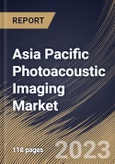Compared to pure ultrasonic imaging, photoacoustic imaging has a better resolution as well as higher penetration than pure optical imaging. As a result, it continues to advance diagnostic imaging in novel methods. Tissues made of living things are subjected to laser pulses during photoacoustic imaging. Ultrasonic transducers can detect the acoustic emission produced when some tissues absorb energy and convert it into heat. Anything that absorbs light, including blood, DNA, RNA, lipid, and melanin (the pigment in the skin), can generate an ultrasonic wave due to the photoacoustic effect.
The widespread usage of photoacoustic imaging is further aided by the increased consumer awareness of preventative healthcare and accessibility. The acceptance of photoacoustic imaging technology is also anticipated to be boosted in the near future by a spike in promotional activity by manufacturers for these devices. The success rate of minimally invasive procedures is also very high. Patient preference for less-invasive photoacoustic imaging, as a result, drives market expansion for both diagnosis and treatment.
With rising life expectancies and falling birth rates, Asia Pacific is rapidly aging, making it the region that is driving one of the most important global demographic trends. In Asia and the Pacific, one in four residents will be older than 60 by the year 2050. The number of people over 60 in the region will increase between 2010 and 2050, reaching over 1.3 billion people. Some countries, like the People's Republic of China, Vietnam, Thailand, and Sri Lanka, will experience this change swiftly, while others, like Indonesia, will experience it more gradually. The market is anticipated to expand significantly due to the increased prevalence of CKD and the aging population.
The China market dominated the Asia Pacific Photoacoustic Imaging Market by Country in 2022, and would continue to be a dominant market till 2030; thereby, achieving a market value of $11,888.3 Thousands by 2030. The Japan market is showcasing a CAGR of 9.2% during (2023-2030). Additionally, India's market would experience a CAGR of 10.6% during (2023-2030).
Based on Product, the market is segmented into Imaging Systems, Transducer, Lasers, and Others. Based on End-user, the market is segmented into Diagnostic Imaging Centers, Hospitals, and Others. Based on Type, the market is segmented into Microscopy, and Tomography. Based on countries, the market is segmented into China, Japan, India, South Korea, Singapore, Malaysia, and Rest of Asia Pacific.
The market research report covers the analysis of key stake holders of the market. Key companies profiled in the report include Fujifilm Holdings Corporation, Advantest Corporation, Prexion Corporation, Seno Medical Instruments, Inc., illumiSonics, Inc., OPOTEK LLC, EKSLPA (EKSMA Group), Verasonics, Inc., Photosound Technologies, Inc., iThera Medical GmbH.
Scope of the Study
By Product
- Imaging Systems
- Transducer
- Lasers
- Others
By End-user
- Diagnostic Imaging Centers
- Hospitals
- Others
By Type
- Microscopy
- Tomography
By Country
- China
- Japan
- India
- South Korea
- Singapore
- Malaysia
- Rest of Asia Pacific
Key Market Players
List of Companies Profiled in the Report:
- Fujifilm Holdings Corporation
- Advantest Corporation
- Prexion Corporation
- Seno Medical Instruments, Inc.
- illumiSonics, Inc.
- OPOTEK LLC, EKSLPA (EKSMA Group)
- Verasonics, Inc.
- Photosound Technologies, Inc.
- iThera Medical GmbH
Unique Offerings
- Exhaustive coverage
- The highest number of Market tables and figures
- Subscription-based model available
- Guaranteed best price
- Assured post sales research support with 10% customization free
Table of Contents
Companies Mentioned
- Fujifilm Holdings Corporation
- Advantest Corporation
- Prexion Corporation
- Seno Medical Instruments, Inc.
- illumiSonics, Inc.
- OPOTEK LLC, EKSLPA (EKSMA Group)
- Verasonics, Inc.
- Photosound Technologies, Inc.
- iThera Medical GmbH
Methodology

LOADING...








